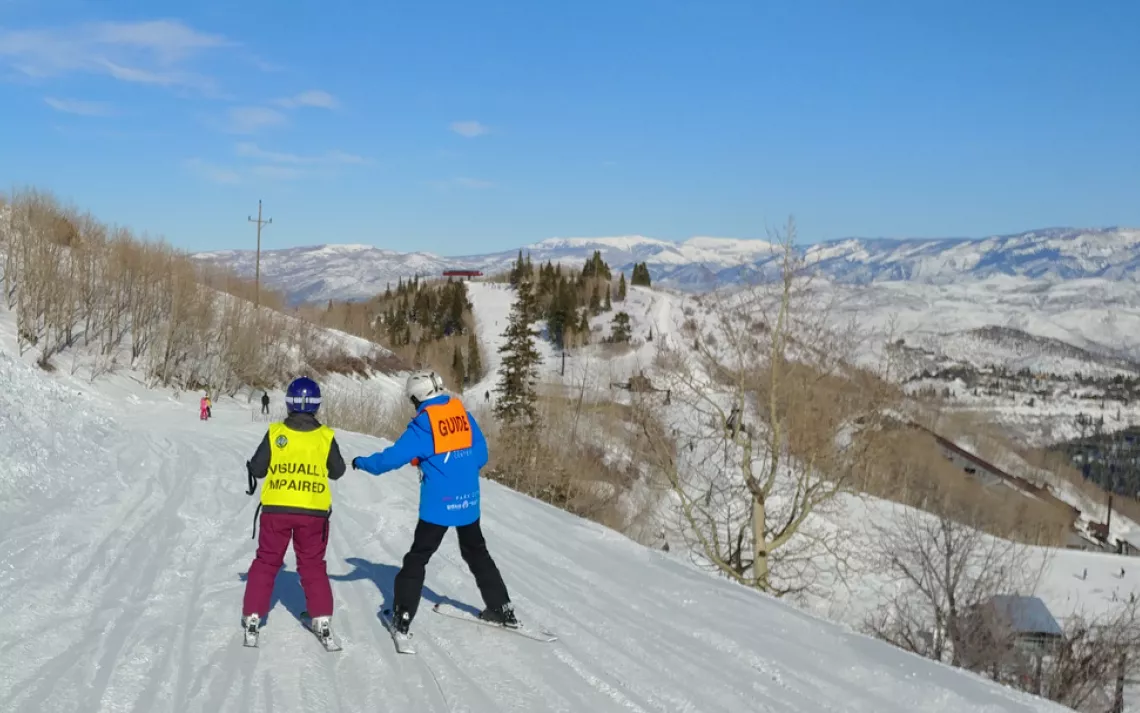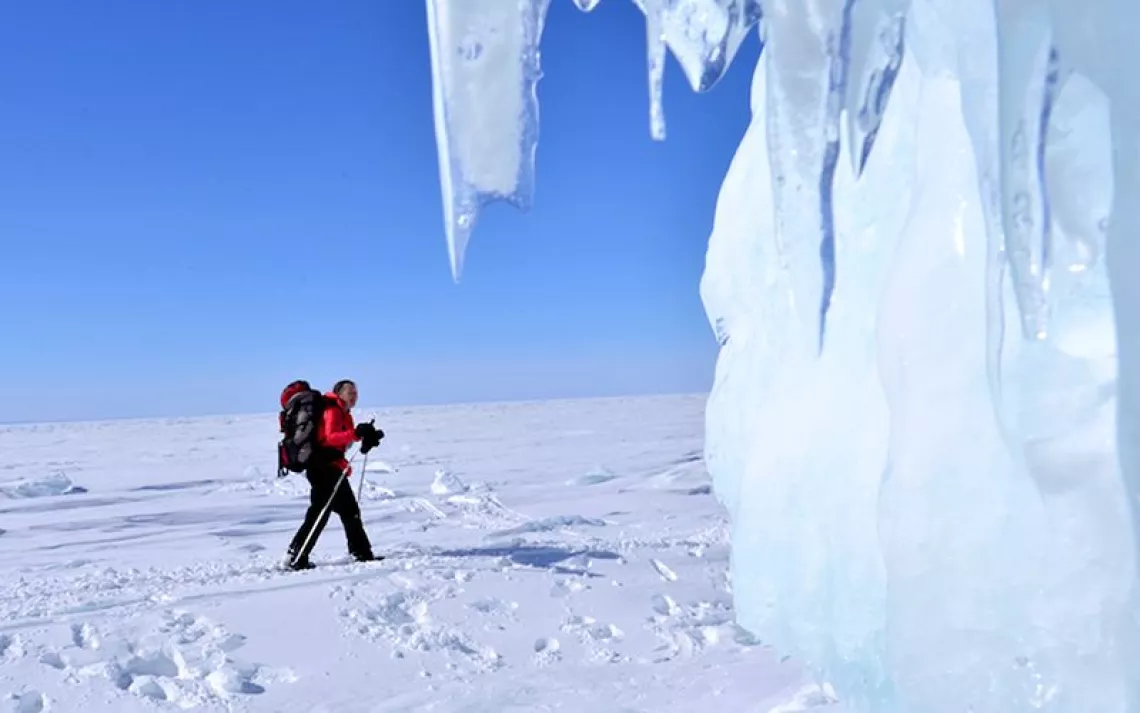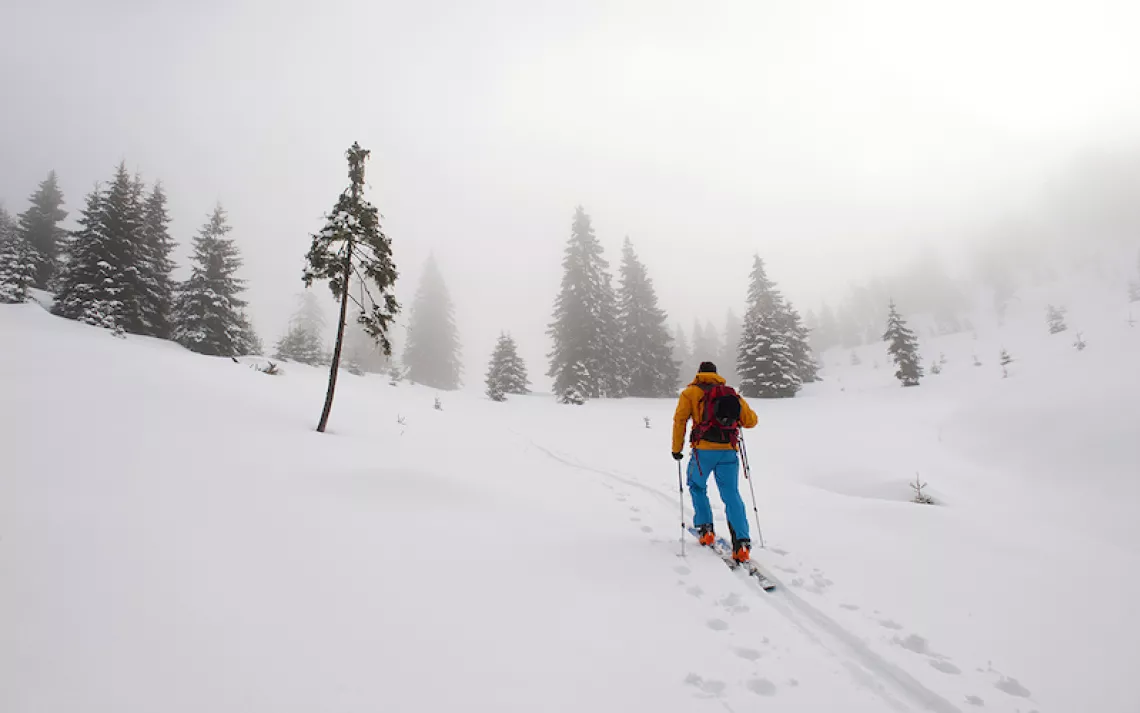Adaptive Strategies
Skiing with the visually impaired at Park City’s National Ability Center

National Ability Center instructor Patricia Stokes guides student Jennifer Kennedy, who is blind, down a mountain.
|Photos courtesy of Lisa Niver
“Hold. Hold. And left turn. Turn. Great job! Lisa, did you see that turn? Hold. Hold. And . . . right turn. Turn, turn.” Instructor Patricia Stokes continues to issue directives as we descend Utah’s Park City Mountain. “OK, now we’re in an open field—you pick your next turns. Feel the slope and decide, but you may want to turn your skis from 9 o’clock to 3 o’clock.” Skiers with visual impairments require continuous auditory cues. It’s why Stokes speaks to her student, Jennifer Kennedy, constantly. If Kennedy, who is blind, cannot hear Stokes, she is to tap her helmet. If the disconnect continues throughout a count to five, she is trained to stop skiing altogether, and drop her uphill hip to the snow.
I am spending a day on the slopes with the National Ability Center (NAC), which began in 1985 as the Park City Handicapped Sports Association. Founders Meeche White and Pete Badewitz were seasoned Coloradoan ski instructors, specializing in individuals with disabilities. In the 30-plus years since hatching the idea of the NAC in their kitchen, their center has grown to serve more than 4,000 individuals with disabilities, providing 28,000 experiences each year. Adventurers with physical, developmental, or cognitive challenges are encouraged to apply to a broad range of programs—the NAC offers year-round opportunities for aspiring skiers and snowboarders, equestrians, mountain bikers, rock climbers, biathletes, archers, and more.
 Here, you see skiers on monoskis and biskis, with color-coded bibs that read, “Visually Impaired,” “Guide,” and “Volunteer.” Stokes, who has been teaching adaptive skiing since 1987 and working with the NAC for the past 12 years, explains that there are many ways to adapt skiing lessons for the differently abled. For starters, she points out that none of us were in fact meant to glide down mountains. Gesturing to my skis, she asks, “Can you get down the mountain without those?” To which I respond, “No, I need my skis!” And that, Stokes says, is why everyone is an adaptive skier. “We are all using an adaptive technology called skis,” she explains. “Some people need poles with skis on the bottom, some need a sit ski, and some need auditory cues.”
Here, you see skiers on monoskis and biskis, with color-coded bibs that read, “Visually Impaired,” “Guide,” and “Volunteer.” Stokes, who has been teaching adaptive skiing since 1987 and working with the NAC for the past 12 years, explains that there are many ways to adapt skiing lessons for the differently abled. For starters, she points out that none of us were in fact meant to glide down mountains. Gesturing to my skis, she asks, “Can you get down the mountain without those?” To which I respond, “No, I need my skis!” And that, Stokes says, is why everyone is an adaptive skier. “We are all using an adaptive technology called skis,” she explains. “Some people need poles with skis on the bottom, some need a sit ski, and some need auditory cues.”
All lift operators and team members here are trained to help skiers of all abilities as they approach lifts and runs. NAC instructors use a variety of techniques with students who have visual impairments, from holding onto a bar alongside pupils while they get a feel for the sensation of downhill skiing, to skiing backwards in front of a student, to control speed, while giving auditory cues. Many also rely on microphones and ear pieces to dispatch these cues from a distance. Staffers are uniformly helpful, well-trained, and extremely responsive to the varying abilities of their students. Some skiers stand to ski, while others use monoskis or biskis (in which a seat and foot rest is mounted on a shock absorber, attached to one or two skis, which allows the skier to turn using handheld outriggers).
 Thanks to NAC’s comprehensive fundraising partnerships and events, 100 percent of skiers and snowboarders with disabilities who apply for scholarships can make their powder dreams come true each season. What’s more, those skiers who live locally, like Kennedy, can partake in multiple sessions throughout the season, with the same highly qualified instructor. Stokes is not only teaching Kennedy to ski this winter; she’s also instructing her husband, Daniel, on how to guide her.
Thanks to NAC’s comprehensive fundraising partnerships and events, 100 percent of skiers and snowboarders with disabilities who apply for scholarships can make their powder dreams come true each season. What’s more, those skiers who live locally, like Kennedy, can partake in multiple sessions throughout the season, with the same highly qualified instructor. Stokes is not only teaching Kennedy to ski this winter; she’s also instructing her husband, Daniel, on how to guide her.
After moving to Utah a few years ago, Kennedy was inspired to give skiing a try, reasoning, “If I don't learn to like something outside, I am gonna be real bored here.” Although Kennedy and her husband hike in the summer and are now learning to ski, the same immune disorder that caused her visual impairment affects her energy levels, so she has to be careful. Having heard great reviews of NAC, however, she decided to hit the slopes.
Stokes uses the clock face model to call out cues as she starts Kennedy on our next run—“12 o’clock” being the direction of Kennedy’s nose. She is to turn to 9 o’clock or 10 o'clock for left, and 2 o’clock or 3 o’clock for right. Once Kennedy’s moving downhill, Stokes employs the word “and” to indicate when it’s time to turn, followed by “left” or “right” to indicate the direction. When Stokes calls out “turn,” Kennedy steers her skis around the turn. If Stokes says “hold,” Kennedy stops steering and holds that line to traverse the hill. Should a situation arise where Kennedy must stop immediately, their agreed-upon word is “halt.” If Stokes shouts it, Jennifer knows to drop her uphill hip into the snow, sit down, and wait for assistance.
 During the chair lift ride for our next run, Stokes asks Kennedy, “Do you feel the difference in the wind?” She continues, “We are passing through a glade of Aspen trees, beneath a bright blue sky. Now we are passing over the giant snow field that we will ski through next.” Kennedy, excited to try new things, opts to take the lift up to 9,250 feet during today’s lesson.
During the chair lift ride for our next run, Stokes asks Kennedy, “Do you feel the difference in the wind?” She continues, “We are passing through a glade of Aspen trees, beneath a bright blue sky. Now we are passing over the giant snow field that we will ski through next.” Kennedy, excited to try new things, opts to take the lift up to 9,250 feet during today’s lesson.
Kennedy explains that visual impairment used to hinder her self-confidence. “In college, I once canceled a date I wanted to go on, because I didn’t think I could get to the location. When I got disoriented, I would just cry. I felt like a 19-year-old prisoner in my own dorm room, afraid to go out. I simply ordered pizza in.”
After college, she spent nine months attending the Louisiana Center for the Blind, a private residential blindness-skills-training center, started by members of the National Federation of the Blind, a consumer advocacy group. There, Kennedy says she learned to be independent and to rely on herself with confidence. Both she and Daniel agree that without that step, they would never have married. Now, to help others in her position find their way, Kennedy teaches cane travel. She maintains her confidence in her abilities, she says, by continually finding ways to challenge herself.
 Life is not about how much you can see; it is about what you do with what you have. There are no “cant’s” at the National Ability Center. The goal is to help everyone experience the freedom of floating down a mountain, the wind rushing by. It’s about overcoming the notion of limitations, with excellent instructors at your side.
Life is not about how much you can see; it is about what you do with what you have. There are no “cant’s” at the National Ability Center. The goal is to help everyone experience the freedom of floating down a mountain, the wind rushing by. It’s about overcoming the notion of limitations, with excellent instructors at your side.
As Anna Benanati, a double leg amputee since age 17, and the only female full-time athlete on staff at the National Ability Center, explains, “Really, I had two choices: I could give up, or I could get up. And I made the conscious decision to get up and keep living.”
 The Magazine of The Sierra Club
The Magazine of The Sierra Club



